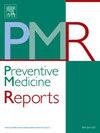围产期抑郁与阳光安全行为:一项试点干预试验的结果
IF 2.4
3区 医学
Q2 PUBLIC, ENVIRONMENTAL & OCCUPATIONAL HEALTH
引用次数: 0
摘要
目的在一项试点干预试验中研究围产期防晒安全行为和并发轻度抑郁症的变化:参加防晒安全计划的孕妇(N = 58)在第二或第三个孕期完成了基线和抑郁症状调查。然后,她们接受了两次 30 分钟的防晒安全辅导。产后一个月和两个月完成随访调查。评估了产前和产后在防晒安全和抑郁方面的差异:基线时,参与者的平均防晒安全得分为 23.2/32(标准差 = 4.4):34.5%的受试者可能患有抑郁症,其日照安全性较低(t = 1.8,df = 56,p < .05)。在第一次随访时,平均日照安全得分上升到 26.5(t = 5.8,df = 57,p < .001),第二次随访时上升到 26.9(t = 5.7,df = 57,p < .001)。在第一次和第二次随访中,基线时可能患有抑郁症的参与者在防晒安全方面的改善较少(t = 3.1,df = 19,p <.01,Cohen's d = 4.3;t = 2.8, df = 19, p < .01, Cohen's d = 4.1)。在第二次随访时,在收入调整后的防晒安全回归模型中,基线防晒安全仍然相关(B = 0.5,SE B = 0.1,p = .001),但与抑郁无关(B = -0.4,SE B = 0.2,p = .09):结论:无论抑郁风险如何,辅导计划都能提高人们对防晒安全的重视程度。本文章由计算机程序翻译,如有差异,请以英文原文为准。
Perinatal depression and sun safety behaviors: Results of a pilot intervention trial
Objective: To examine changes in perinatal sun safety behavior and co-occurring minor depression in a pilot intervention trial.
Methods: Pregnant women (N = 58) in a sun safety program completed baseline and depression symptom surveys during their second or third trimesters. They then underwent two 30-min sun safety counseling sessions. Follow-up surveys were completed one- and two-months postpartum. Differences in pre- and postpartum sun safety and depression were evaluated.
Results: At baseline, participants' mean sun safety score was 23.2/32 (SD = 4.4): 34.5 % were identified as likely depressed and had lower sun safety (t = 1.8, df = 56, p < .05). The mean sun safety score rose to 26.5 at the first follow-up (t = 5.8, df = 57, p < .001) and 26.9 (t = 5.7, df = 57, p < .001) at the second. Participants who were likely depressed at baseline experienced less improvement in sun safety at the first and second follow-ups (t = 3.1, df = 19, p < .01, Cohen's d = 4.3; t = 2.8, df = 19, p < .01, Cohen's d = 4.1, respectively) than those not depressed (t = 4.9, df = 37, p < .001, Cohen's d = 4.3; t = 5.0, df = 37, p < .001, Cohen's d = 5.4, respectively). In an income-adjusted regression model of sun safety at the second follow-up, baseline sun safety remained associated (B = 0.5, SE B = 0.1, p = .001) but not depression (B = -0.4, SE B = 0.2, p = .09).
Conclusions: The counseling program increased sun safety adherence, regardless of depression risk.
求助全文
通过发布文献求助,成功后即可免费获取论文全文。
去求助
来源期刊

Preventive Medicine Reports
Medicine-Public Health, Environmental and Occupational Health
CiteScore
3.90
自引率
0.00%
发文量
353
 求助内容:
求助内容: 应助结果提醒方式:
应助结果提醒方式:


